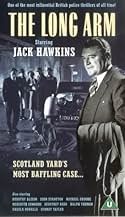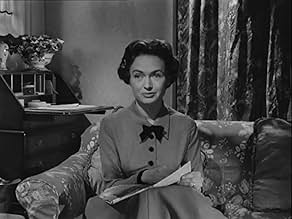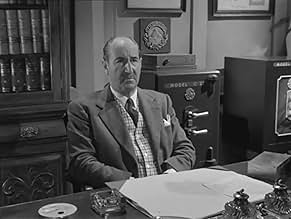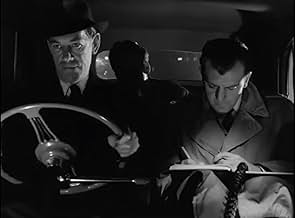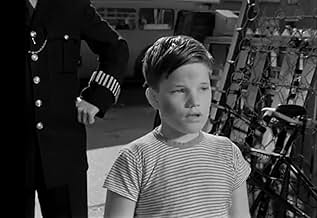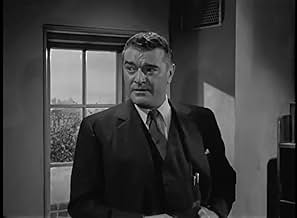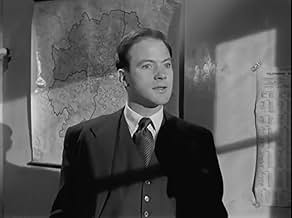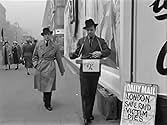IMDb RATING
7.0/10
1.5K
YOUR RATING
The sleuths of Scotland Yard try to solve a series of burglaries.The sleuths of Scotland Yard try to solve a series of burglaries.The sleuths of Scotland Yard try to solve a series of burglaries.
- Nominated for 1 BAFTA Award
- 1 win & 1 nomination total
Featured reviews
This is a superb police detection drama, with Jack Hawkins as the warm-hearted focus of a rather complex crime saga. The best supporting performance is by Ursula Howells, who brilliantly conveys neurotic menace and desperation in just a few scenes. The young Ian Bannen is killed off very quickly, but already in this early appearance we can see his superior qualities working on screen. This 1956 British film is clearly an attempt to emulate the 1940s and 1950s Hollywood films such as 'The House on 92nd Street', directed by Henry Hathaway, since it also portrays stolid and patient police work, shown in loving detail. There are no 'noir' elements to this drama, and the crime is just crime, with no psychology or angst. The plot has some intriguing novelties. In the first safe robbery at the beginning of the film, the thief remains at the scene of the crime and pretends to be a night watchman, lets the police in, shows sympathy and bewilderment, and then makes his escape after they have gone. The whole case really is a brain-teaser, and well worth viewing by any chess player or detective enthusiast. It is a superior British film of its genre.
Very solid brit crime drama. Fine performance from Jack Hawkins. Thankfully, not so much stiff upper lip as we were used, the humour between Hawkins and his sidekick the John Stratton bubbles along and the mechanics of the plot is nicely constructed and presented. A veritable glut of fine British actors both future stars like Ian Bannon and Stratford Johns and small part favourites like Sam Kydd and Harold Goodwin. Also keep an eye out for a young Nicholas Parsons playing a copper. If you're a resident of London it will be fascinating looking at the sites of our capital and seeing how much it has changed. An undiscovered gem worth digging out
The Long Arm is an excellent film in my opinion, for 2 main reasons. Firstly it captures all the elements of a typical 1950s British film, with typical London landmarks, familiar faces from other movies, and accents and a way of life portrayed from that era prior to the onset of the society-changing 1960s. Secondly the movie provides, for someone watching for the first time, a thrilling plot with several twists which keep you interested right to the end.
Hawkins is superb as the central character - with the investigation of a hit-and-run murder obviously a more serious crime in 50s London than nowadays. This is the sort of film to watch if you are off work on a midweek afternoon.
Hawkins is superb as the central character - with the investigation of a hit-and-run murder obviously a more serious crime in 50s London than nowadays. This is the sort of film to watch if you are off work on a midweek afternoon.
The Long Arm is directed by Charles Frend and written by Janet Green and Robert Barr. It stars Jack Hawkins, John Stratton, Dorothy Alison and Michael Brooke. Music is by Gerard Schurmann and cinematography by Gordon Dines.
Detective-Superintendent Tom Halliday (Hawkins) heads up an investigation into a number of safe cracking robberies. Which in turn turns into a murder investigation.
Out of Ealing Studios, this is a little cracker of a police procedural detective mystery. The flow of the investigation is natural, not given over to wild implausibilities, and always the air of mystery is potent. On the outskirts of the investigation there's a running thread about how policemen's wives/girlfriends suffer in their own ways, their men are married to the force, and this is delicately handled by the makers. While the moments of wry levity are not misplaced. Production is spiffing, with a number of London locations vibrantly used and given a film noir sheen by Dines (The Blue Lamp), while Frend (Scott of the Antarctic) keeps it tight and interesting whilst getting grand perfs from the cast - notably a wonderfully regal Hawkins.
So if you are looking for an old time British policer that doesn't insult your intelligence, then you need look no further. 8/10
Detective-Superintendent Tom Halliday (Hawkins) heads up an investigation into a number of safe cracking robberies. Which in turn turns into a murder investigation.
Out of Ealing Studios, this is a little cracker of a police procedural detective mystery. The flow of the investigation is natural, not given over to wild implausibilities, and always the air of mystery is potent. On the outskirts of the investigation there's a running thread about how policemen's wives/girlfriends suffer in their own ways, their men are married to the force, and this is delicately handled by the makers. While the moments of wry levity are not misplaced. Production is spiffing, with a number of London locations vibrantly used and given a film noir sheen by Dines (The Blue Lamp), while Frend (Scott of the Antarctic) keeps it tight and interesting whilst getting grand perfs from the cast - notably a wonderfully regal Hawkins.
So if you are looking for an old time British policer that doesn't insult your intelligence, then you need look no further. 8/10
A brilliant thriller, and the more brilliant for dealing only with non-violent criminality of an advanced technical kind, as the burglar in question is a professional who has worked out a system of foolproof and almost impeccable systematization of his craft, which never can exclude the human factor, though, - and naturally,. even he must commit mistakes. There is only one casualty, the young Ian Bannen in one of his first parts, and he acts it brillantly, like Errol Flynn in his first film part was a glorious dead body and nothing else. The cinematography is also excellent, and the climax is not missing. Jack Hawkins as the leading police officer is reliable as usual, and all others are also quite on the level. It's a brilliant film on a B level but rises up to A for its excellent handiwork and keeps you busy and engaged all the way, from the smallest minor details in the beginning to a sustained suspense in the end. Almost 10 points.
Did you know
- TriviaThe last film made at Ealing Studios, London.
- GoofsWhen a kid try to sell a new car's lamp, the policeman took him back to the junk yard and the lamp is still in car.
Sorry, not a goof. The two lamps on the front of the damaged car are the headlights, or lamps if you prefer. The boy had taken the fog lamp off the car. The fog lamp was a third lamp as may be seen at 34 mins when the collision occurs. The fog lamp is clearly seen on the nearside just above the bumper. When the car is on on the dump, the fog lamp is not there.
- Quotes
[during the final chase, Halliday leaps onto the bonnet of the getaway car and stops it by smashing its windscreen with his truncheon; as it lurches to a halt, he falls off the bonnet onto the ground. Ward helps him up]
Detective-Sergeant Ward: Are you all right, sir?
Detective-Superintendent Tom Halliday: I'll live, I think.
Detective-Sergeant Ward: Nothing broken?
[Halliday pauses and looks mortified]
Detective-Superintendent Tom Halliday: Yes - a promise I made to let *other* people take the risks!
- Crazy creditsSPOILER: In the end credits Ursula Howells is credited twice: first as her fake character Mrs. Elliot, and then at the end as Mrs. Gilson, the wife of Gilson the criminal.
- ConnectionsReferenced in The Kiss (1958)
- How long is The Third Key?Powered by Alexa
Details
- Release date
- Country of origin
- Language
- Also known as
- The Third Key
- Filming locations
- Pen-Y-Gwryd, Gwynedd, Wales, UK(Mr Thomas's garage where the newspaper was delivered)
- Production company
- See more company credits at IMDbPro
- Runtime1 hour 36 minutes
- Color
- Aspect ratio
- 1.85 : 1
Contribute to this page
Suggest an edit or add missing content


